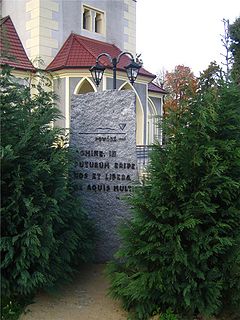1997 Central European flood
| A stone in the Silesian village of Cisek, Poland in memory of the flood. | |
| Duration: | July 1997 |
| Fatalities: | 105-115 (55 in Poland, 50-60 in Czech Republic) |
| Damages: | $4.5 billion |
| Areas affected: | Czech Republic, Poland, Germany |
The 1997 Central European flood or the 1997 Oder Flood of the
Causes
Waters rose as the results of two extensive rain periods (4-10 July and 17-22 July) in southwestern Poland and northern Czech Republic.
The cause of precipitation was low pressure, which from northern Italy to
The precipitation was very high, at the level of 300–600 millimetres (12–24 in), the equivalent - over few days - over several months worth of averages. The waters have risen 2-3m above the previously recorded averages, and were so high that they flooded over standing measurement poles. The heavy rains of that period in that region were among the largest rains in the recorded world's history. The reasons the flood was called the Millennium Flood was because the chances of such a flood were estimated at 0.1% chance a year.
Floods
Already on July 5 flooding begun in the Czech Republic, and on July 6 floods spread to Poland. Those early floods were
On 18 July, Polish president
Water levels
Water levels recorded on
Damage
The flood took lives of 105-115 people (55 in Poland, 50-60 in Czech Republic) and causing material damages estimated at $4.5 billion (3.8 billion euros in the Czech Republic and Poland and 330 million euros in Germany).
In Poland, it is estimated that 7,000 people lost all of their possessions. 9,000 private businesseses were affected, 680,000 houses were damaged or destroyed, as well as 843 schools (100 destroyed), 4,000 bridges (45 destroyed), 14,400 km of roads, 2,000km of railways. In total, 665.835 hectares were affected in Poland (an estimated 2% of Polish total territory). The losses were estimated at 63 billions of Polish
In the Czech Republic, there were 50 fatalities (another source gives 60). 2151 flats and 48 bridges were destroyed. 538 villages and towns were affected. The losses were estimated at 63 billions of
In Germany there were no fatalities.
Responses
Government response in Czech Republic and Poland was criticized. The flood revealed various inadequacies in decision making and infrastructure, although the unprecedented magnitude of the disaster can be seen as a mitigating factor.
Numerous charities provided aid to those affected by the floods.
See also
References
External links
Retrieved from : http://en.wikipedia.org/wiki/1997_Central_European_flood
